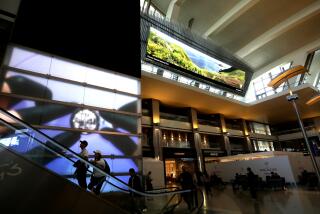Giving in to the lure of Las Vegas, Nirvana
In the 1995 film “Leaving Las Vegas,” Nicolas Cage goes to Las Vegas to drink himself to death. He decides to drive. He drives for the finality of it, and probably because going to the Strip to kill yourself just doesn’t seem quite as romantic or metaphorical when you’re standing in line at the Southwest Airlines ticket counter at the Burbank airport, holding a brownish placard that has the number 73 on it.
How one chooses to get to Vegas, assuming it’s not for suicide, is often determined by pragmatism, like length of stay or a fear of flying. But there are subtler forces at play, ones that can set the tone for a weekend getaway before you even leave L.A.
Lately, I’ve been flying more than driving, on the theory that I don’t want to have to deal with my car when I get there, and because bargain fares make it all seem so easy and affordable.
And to a large extent this is true. The happiest flights I’ve ever taken are the ones that leave for Las Vegas on a Friday. Note the merriment on the plane as would-be winners start their weekend early. Laughter fills the cabin.
When the pilot comes over the intercom to inform you that the plane will be landing 10 minutes early, you remind yourself to shake his hand as you disembark, to congratulate him on a job well-done. Pilots, you tell yourself, should be thanked more often, as opposed to taken for granted. Besides a handshake for the pilot will surely establish good gambling karma through the weekend.
Alas, the pilot is in mid-conversation with a flight attendant, and you don’t feel like interrupting. Besides, you’re distracted -- you can already hear the bells coming from the slot machines in the terminal. They propel you forward, like being released into the wild, after years spent huddled and wet in a cage.
Note the bounce in your stride, the cut of your jib (whatever that means). For me, nothing symbolizes the freedom to pursue red-blooded American gluttony quite like landing in Vegas with an overnight bag and a wad of cash, your everyday responsibilities (including your car) garaged for the weekend.
The cab lines are quick. The cabbies, a multicultural group if ever there was one, normally friendly. An hour ago, you were in L.A. Now you’re on the Strip, in all its improbable glory.
The only trouble with flying is the return trip. Suddenly, all those pals on the flight two days ago transform into these annoying, blood-gorged beasts -- losers, winners, who cares? -- standing between you and the sanctuary of home. That wonderful human being of a pilot? Now he’s telling you, sorry, folks, looks like it’ll be another 15 minutes here on the ground at LAX, until that other plane vacates its parking space.
It wasn’t until recently, when I drove to Vegas solo, that I came to appreciate the restorative pleasures of the round-trip hours in the car. I hadn’t done it in years, and I’d forgotten how much more symbolic sense it made.
Heading out of L.A., the weekend unfolds before you. The slow approach into the desert seems almost biblical, the fast-food neon of Barstow yielding to panoramic views of a landscape that seems other-planetary.
And then, of course, the moment of truth: Vegas, the city of sin, suddenly reveals itself on the horizon.
The return trip, save for one caveat (L.A.-area traffic), offers its own pleasures. After 48 or 56 hours amid the mass of humanity that Vegas attracts, the car becomes a sanctuary.
The free-and-easy ability to move between L.A. and Vegas has made the Strip a Southern California suburb, no less commutable than, say, downtown to Hermosa Beach. To drive there is to understand that the two places are worlds apart.
*
Paul Brownfield can be reached via e-mail at [email protected].
More to Read
Sign up for The Wild
We’ll help you find the best places to hike, bike and run, as well as the perfect silent spots for meditation and yoga.
You may occasionally receive promotional content from the Los Angeles Times.






